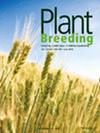Influence of red–blue light ratio on the phenology and morphology of different lentil (Lens culinaris Medik) and chickpea (Cicer arietinum) genotypes under a simple and resource‐efficient in‐house speed breeding method based on the application of extended photoperiod
IF 1.8
4区 农林科学
Q2 AGRONOMY
引用次数: 0
Abstract
In the complex context of rising food demand, natural resources degradation and worsening climate changes impact, food legumes could play an important role in sustainable agriculture and food security. To overcome these challenges, enhanced genetic gain has become a necessity. Speed breeding‐based extended photoperiod is being used to reinforce conventional breeding methods and to speed up the development of adapted varieties. Speed breeding growth chambers and greenhouses' light quality in terms of red–blue ratio is among important factors that need to be optimized to enhance the efficiency of this technique to accelerate plant growth and development while limiting plant stress. We have compared the effect of different light ratios of 5:3 red–blue, 3:5 red–blue and 4:4 white–white on phenological and morphological characteristics of three lentil and chickpea genotypes grown in a speed breeding‐based extended photoperiod growth chamber with 22 h light/2 h dark. The 5:3 red–blue light ratio increased plant height and reduced flowering time for the three tested lentil varieties with 36, 41 and 40 days after sowing, respectively, as well as for the three tested chickpea varieties with 42, 38 and 24 days after sowing, respectively. While the 3:5 red–blue ratio increased leaves and secondary stem growth for lentil; leaves and secondary stem growth, green canopy cover and seedling vigour for chickpea. Less vegetative growth and later flowering were observed under white light. Higher red–blue light ratio of 5:3 accelerated lentil and chickpea vegetative growth and flowering, making it more optimal for speed breeding‐based extended photoperiod. It should be pointed out that the suggested home‐designed and built protocol is cost‐effective and easy to implement especially in small‐scale breeding programmes in developing countries.在基于延长光周期的简单且资源节约型内部快速育种方法下,红蓝光比对不同扁豆(Lens culinaris Medik)和鹰嘴豆(Cicer arietinum)基因型的表型和形态的影响
在粮食需求不断增长、自然资源退化和气候变化影响日益加剧的复杂背景下,食用豆科植物可在可持续农业和粮食安全方面发挥重要作用。要克服这些挑战,就必须提高遗传增益。目前正在利用基于延长光周期的快速育种来强化传统育种方法,加快适应性品种的开发。快速育种生长室和温室在红蓝比方面的光质是需要优化的重要因素之一,以提高该技术的效率,加快植物生长和发育,同时限制植物胁迫。我们比较了 5:3 红蓝光、3:5 红蓝光和 4:4 白白光不同光比对在 22 小时光照/2 小时黑暗的基于速度育种的延长光周期生长室中生长的三种扁豆和鹰嘴豆基因型的表观和形态特征的影响。红蓝光比为 5:3 的三个受试扁豆品种在播种后 36 天、41 天和 40 天的植株高度有所增加,开花时间有所缩短;三个受试鹰嘴豆品种在播种后 42 天、38 天和 24 天的植株高度有所增加,开花时间有所缩短。红蓝比为 3:5 时,小扁豆的叶片和次生茎生长量增加;鹰嘴豆的叶片和次生茎生长量、绿色冠层覆盖率和幼苗活力增加。在白光下,无性生长较少,开花较晚。5:3 的较高红蓝光比可加速扁豆和鹰嘴豆的无性生长和开花,使其更适合基于延长光周期的快速育种。应该指出的是,所建议的自行设计和构建的方案具有成本效益,易于实施,尤其适用于发展中国家的小规模育种计划。
本文章由计算机程序翻译,如有差异,请以英文原文为准。
求助全文
约1分钟内获得全文
求助全文
来源期刊

Plant Breeding
农林科学-农艺学
CiteScore
4.40
自引率
5.00%
发文量
74
审稿时长
3.0 months
期刊介绍:
PLANT BREEDING publishes full-length original manuscripts and review articles on all aspects of plant improvement, breeding methodologies, and genetics to include qualitative and quantitative inheritance and genomics of major crop species. PLANT BREEDING provides readers with cutting-edge information on use of molecular techniques and genomics as they relate to improving gain from selection. Since its subject matter embraces all aspects of crop improvement, its content is sought after by both industry and academia. Fields of interest: Genetics of cultivated plants as well as research in practical plant breeding.
 求助内容:
求助内容: 应助结果提醒方式:
应助结果提醒方式:


